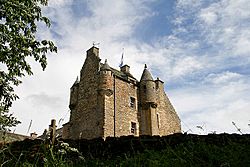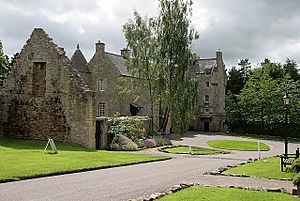Ferniehirst Castle facts for kids
Quick facts for kids Ferniehirst Castle |
|
|---|---|
| South of Jedburgh, Scotland | |

Ferniehirst Castle, keep
|
|
| Coordinates | 55°27′16″N 2°33′04″W / 55.45444°N 2.55111°W |
| Site information | |
| Owner | Lord Ralph Kerr |
| Open to the public |
Yes (July) |
| Site history | |
| Built | 1470 |
| Built by | Clan Kerr |
| In use | Residential |
| Battles/wars | occupied by the English in 1547-49 during the Rough Wooing |
Ferniehirst Castle (sometimes spelled Ferniehurst) is an old L-shaped castle. It stands on the east bank of the Jed Water, about two kilometers south of Jedburgh. This area is in the Scottish Borders of Scotland. The castle has been the historic home of the Clan Kerr family for centuries. After being used for other purposes, it was brought back to life as a home. This restoration was done by Peter Kerr, 12th Marquess of Lothian, in the late 1900s.
Contents
History of Ferniehirst Castle
Ferniehirst Castle has a long and exciting history. It has seen many conflicts and changes over the centuries.
Early Conflicts and English Occupation
The Kerr family built the first castle around 1470. In 1547, during a war called the Rough Wooing, English soldiers took over the castle. This war was about England trying to get Scotland to agree to a marriage.
In February 1549, the Kerr clan, led by Sir John Ker, fought back. They were helped by French soldiers. They used artillery to attack the castle gate. Soldiers also used picks to break down the walls. The English captain and his soldiers were defeated.
An English army, led by the Duke of Rutland, took the castle again in June 1549. However, this war was almost over.
Raids and Royal Attacks
In January 1570, the Countess of Northumberland, who was in exile, stayed at Ferniehirst Castle.
On April 18, 1570, English forces attacked the castle. This was after Sir Thomas Ker had raided northern England. The attack also aimed to scare supporters of Mary, Queen of Scots. Another English army damaged the castle in 1573. This happened as they marched towards Edinburgh Castle.
Later, in 1593, King James VI attacked the castle. This was because the Kerrs had helped Francis Stewart, who was plotting against the king. For a long time, the Kerr family were important leaders in the border areas. Because the castle was damaged, rebuilding started in 1598.
Later Life and Modern Use
The castle was not used much in the 1700s. It was repaired and got a new roof around 1830. A big part of it was restored again in 1890.
From 1934 to 1984, it was a Scottish Youth Hostels Association hostel. This means it was a place for young travelers to stay. During the Second World War, the army used it for soldiers.
In 1988, major repairs and changes were made. Peter Kerr, 12th Marquess of Lothian, oversaw this work. The castle became a private home once more. Today, his second son, Lord Ralph Kerr, lives there. He also owns Melbourne Hall in England. The castle is open to visitors during July. It is a very important historic building.
The Ker Chapel, built in the 1600s, is also part of the property. It was likely a chapel for funerals. It got a new roof in 1938. In 1988, it was carefully repaired and changed. Now, it is a visitor center. It is also a very important historic building.
What Does Ferniehirst Castle Look Like?
Ferniehirst Castle is an L-shaped fortress. The shorter part of the "L" is a tower from the 1500s. This tower holds the main staircase.
Unique Staircase Design
The main staircase is a spiral staircase. It winds upwards in a counter-clockwise direction. This is why it's called the "left-handed staircase." The story says that in 1513, Sir Andrew Kerr returned from the Battle of Flodden. He was left-handed. He then taught his men to fight with their left hands. In Scotland, being left-handed is sometimes called "Corrie-fisted" or "Kerr-handed." This staircase design would make it harder for right-handed attackers to use their swords.
Defensive Features and Style
The castle has many "shot-holes." These are small openings that allowed muskets to fire from many angles. There are also smaller "shut-holes" for air.
Ferniehirst also has cool, cone-shaped towers at its corners. These are called "studies." They are not mainly for defense. Instead, they open from the rooms on the upper floors. You can see some fancy Renaissance-style decorations around the windows and doors. You enter the castle through a classic-looking archway.
Images for kids





